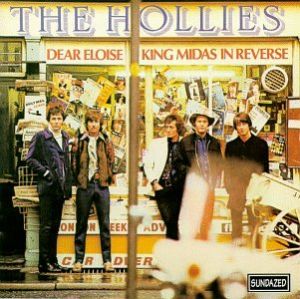
- Format: MP3

With Graham Nash chafing at the bit for pop respectability, the Hollies started getting "heavy" and "relevant" on this 1967 outing, their second full-blown psychedelic album of the year. It was already clear, if not stated overtly, that Nash would be on his way out of the lineup sooner rather than later, and the irony was that the group generated some of its strongest album tracks during this period, representing some of the most inventive original compositions in its history. Their take on psychedelic music remained rooted within a pop context, especially in America, where the Butterfly album was stripped of three of its spacier songs — "Pegasus," "Try It," and "Elevated Observations" — and gained the contemporary single "King Midas in Reverse"; the latter represented perhaps their best work in a psychedelic vein, and it was nowhere near as ambitious as the Beatles' "Strawberry Fields Forever," much less, say, "Tomorrow Never Knows." "Dear Eloise" opened the U.K. and U.S. versions of the album, all glowing harmonies and a few tape tricks and tempo shifts around Moon/June lyrics, with the flute- and trumpet-accompanied pop ballad "Away Away Away" nudging listeners into a more upbeat mode. "Maker" opens with the drone of sitars and a gently played tabla, veering into low-keyed raga-rock until the end of the verses, which suddenly shift into a pop-waltz tempo for a few bars, return to the raga, and repeat the process once; it wasn't Top 40 material, but it was vastly inventive and daring for a group that, until 18 months before, had hardly been known for its original songs or its invention. "Would You Believe" offers a beat and texture that paralleled Donovan's "Atlantis," with the added effect of lots of reverb-soaked bells. "Wishyouawish" was roughly the Manchester equivalent to "The 59th Street Bridge Song (Feelin' Groovy)," about a lazy afternoon amid the Summer of Love, while "Post Card" was a briskly paced guitar-and-drums driven track that might've been a holdover from For Certain Because and which might've been a single if it only had an ending. "Charlie & Fred" — the favorite song off the album by teen pop columnist Gloria Stavers, according to the original notes — is one of those uniquely English character study songs, about a perennially displaced, downtrodden member of society; it's closer to Ginger Baker's "Pressed Rat and Warthog" from Cream's Wheels of Fire, than, say, to Pink Floyd's "Arnold Layne" — the hooks are mostly in the middle eight and the bridge, which also gets an alto trumpet embellishment, and the piece ultimately falls close to "Penny Lane" amid its blooming harmonies; it also ends on a gorgeous a cappella verse. "Step Inside" is a trippy invitation to tea and crumpets from an illicit companion, carrying the glow of the Summer of Love with a beautifully written and sung chorus. "Butterfly" was an overt art song, complete with full orchestral accompaniment and a hauntingly subdued mood, and "King Midas in Reverse" closed the record on a radiant upbeat note. The 1997 Sundazed reissue — amazingly, the first reissue of the album in America since the original LP disappeared in 1969 — restores "Pegasus," "Try It," and "Elevated Observations" and adds the July 1968 single "Do the Best You Can," which is actually almost a post-psychedelic track, heavy on banjo and harmonica (and, thus, more of a piece with the instrumentation on the Hollies Sing Dylan album) with some lingering trippiness in its mood; but it's also obvious hearing it why Nash was so eager to exit, its pop sensibilities seeming very lightweight — like the lighter side of the Tremeloes or the Marmalade — in the spring of 1968. The mastering is good enough, with a clean sound and warm textures, though the more recent reissues from England and Japan have an edge in that department; the annotation is a bit frustrating, as it is made up primarily of an interview with Allan Clarke — the author tries to get him to address the album, its content, and recording, but they keep turning back to the subject of Nash's friendship with Stephen Stills and David Crosby and his eagerness to leave the Hollies, and the result is precious little about the music or the album.